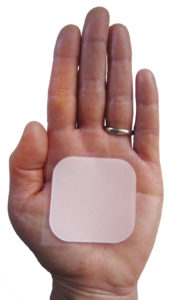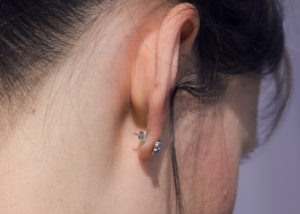Have you ever woken up in the morning, gotten ready for the day, put some earrings on, and thought, “Man, I wish this jewelry was also birth control”?
… No? Me either!
A study was published in early 2019 looking into “pharmaceutical jewelry,” or jewelry that adapts the concept of the transdermal drug delivery system. Transdermal means across the skin and this technology serves as an alternative to oral delivery and traditional needle injection of medicine by dispensing drugs through a patch that sticks to the skin. The patch slowly releases the drug, which can penetrate the skin either through the layers of the skin or pass through sweat glands and across hair follicles. From there the drug is absorbed into the circulatory system, where it can be used in the body.
This technology was first applied in 1979 for a three-day patch containing scopolamine, a drug used to treat motion sickness. Patches have since been used to dispense many other drugs, including the commonly known nicotine patch, which was designed to help smokers quit smoking by systematically reducing the user’s dependence on the drug.
Transdermal contraceptive patches, otherwise known as birth control patches, were invented in 2001. They are 99% effective when used perfectly (e.g. stuck on well and replaced on time). Similar to other medicines delivered via a patch, the birth control patch negates the need use of oral contraceptives. The patch only needs to be changed once every 7 days for 3 weeks and then the user can choose to either menstruate for one week by leaving the patch off, or skip menstruation by wearing a new patch.
While the birth control patch is an improved option for those who dislike oral contraceptives and those who don’t want invasive contraceptive options (such as an IUD or the implant), the patch does have a few drawbacks. The patch must be changed on time every 7 days and, although designed with a strong adhesive, it does have the potential to fall off. Although the patch can be hidden under clothes, it may still be visible to partners or others depending on the location in which the user chooses to place it.
Enter pharmaceutical jewelry. In an attempt to make more contraceptive options widely available, postdoctoral fellow Mohammad Mofidfar, senior research scientist Laura O’Farrell, and Professor Mark Prausnitz adapted transdermal patch technology to jewelry in the form of earring backs. The researchers tested a small patch consisting of three layers ( two outer adhesives to hold onto the earring back and to stick to the skin for drug transfer, and a middle layer containing the contraceptive) both ex vivo on pig ear skin and in vivo on the skin of hairless rats. In one week, the patches were able to deliver approximately the same amount of drug in both conditions in relatively steady quantities that were well above the human contraceptive threshold.
Understanding that jewelry wearers may remove earrings at night to sleep, the researchers simulated a similar situation in which the patches were applied to rat skin for 16 hours and then removed for 8 hours. Levels of the contraceptive drug did drop during the removal period but overall remained higher than the human contraceptive threshold for the entirety of 7 days. The researchers noted that the patch was well tolerated on the rats’ skin with no signs of reddening or irritation.
The most critical limitation to assess is whether the contraceptive drugs can be effective with a low enough dose to fit into the limited space of the small patch. While no human testing has been done yet, this initial testing on animals suggests that the contraceptive jewelry may deliver sufficient amounts of hormone to provide adequate contraception for humans. It is also noted that users would need to change the earring back likely on a weekly basis, meaning that they would need multiple earring backs to continue the contraception.
While quite a few questions remain – would a patch go on both earring backs for the left and right ears? Would the user need to wear the earring(s) for a full 16 hours? Might this work with other jewelry pieces, such as watches or necklaces? Couldn’t a smaller birth control patch just be invented? – the possibility of pharmaceutical jewelry is intriguing. The earring back could be universal and worn with any earrings the user wants, and if the user wears earrings on a regular basis, this could encourage them to remember to use it. As this new technology continues to develop, we will definitely be on the lookout for more updates on the concept of contraceptive jewelry.
Peer edited by Priya Hibshman

